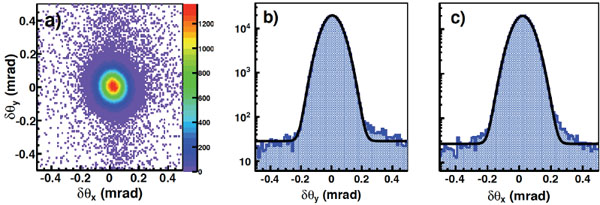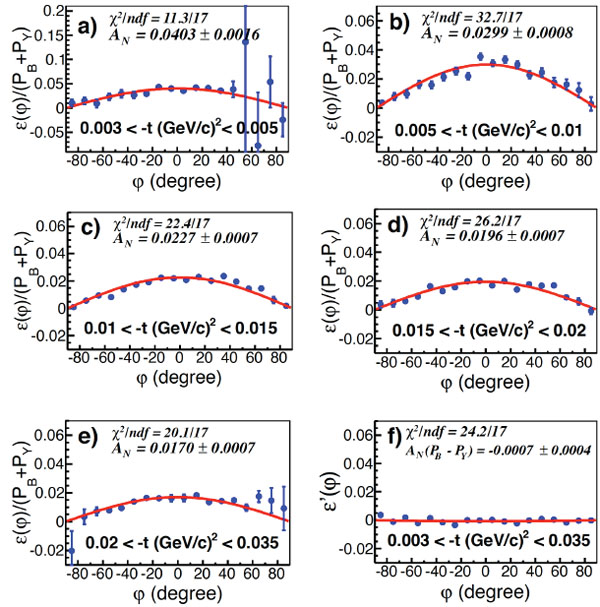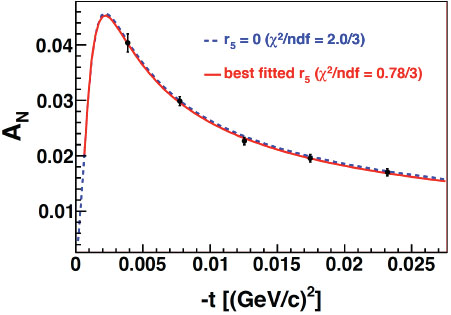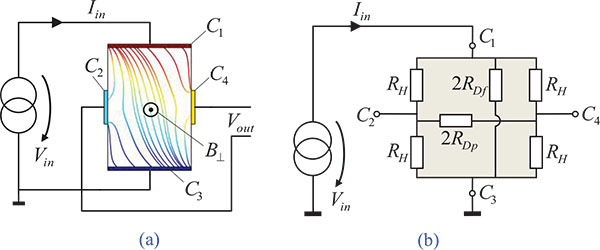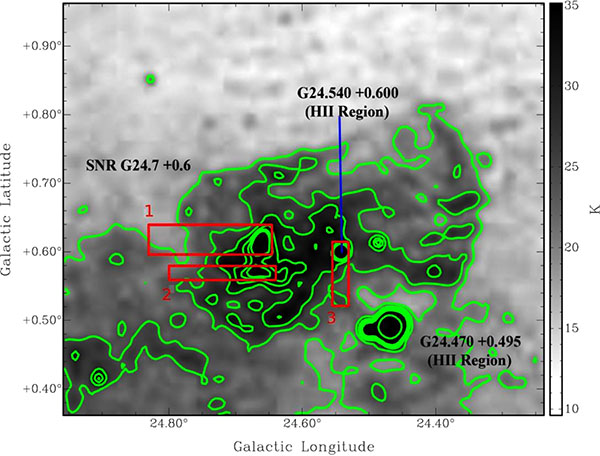RESEARCH ARTICLE
Physics with Tagged Forward Protons at RHIC§
Kin Yip*
Article Information
Identifiers and Pagination:
Year: 2014Volume: 1
Issue: Suppl 1: M7
First Page: 52
Last Page: 56
Publisher Id: PHY-1-52
DOI: 10.2174/1874843001401010052
Article History:
Received Date: 25/11/2013Revision Received Date: 24/12/2013
Acceptance Date: 25/12/2013
Electronic publication date: 31/12/2014
Collection year: 2014
open-access license: This is an open access article licensed under the terms of the Creative Commons Attribution Non-Commercial License (http://creativecommons.org/licenses/by-nc/3.0/) which permits unrestricted, non-commercial use, distribution and reproduction in any medium, provided the work is properly cited.
Abstract
Here we describe diffractive measurements at RHIC in proton+proton collisions with a special optics run of β*~21 m at STAR, at the center-of-mass energy GeV during the the RHIC 2009 run. We present published results of single spin asymmetry as well as preliminary results on double spin asymmetries and central exclusive production.
PACS Number(s): 13.85.Dz and 13.88.+e.
1. INTRODUCTION AND THEORETICAL FORMALISM
Elastic scattering of polarized protons at small four momentum transfer squared
 is described by interference of Coulomb and nuclear amplitudes. Coulomb amplitude is calculable by QED and such interference provides a unique opportunity to study the dynamics of the strong interaction in the nonperturbative region. The total cross section was measured to very high energy and turned out to be in a good agreement with the description by the Regge pole exchange. At ultra relativistic energies the main contribution comes from Pomeron or, in modern terms, multigluon exchange [1]. Most of the previous experiments were done with unpolarized beams and targets. The first measurement with polarized protons at high energies in the Coulomb nuclear interference (CNI) region
is described by interference of Coulomb and nuclear amplitudes. Coulomb amplitude is calculable by QED and such interference provides a unique opportunity to study the dynamics of the strong interaction in the nonperturbative region. The total cross section was measured to very high energy and turned out to be in a good agreement with the description by the Regge pole exchange. At ultra relativistic energies the main contribution comes from Pomeron or, in modern terms, multigluon exchange [1]. Most of the previous experiments were done with unpolarized beams and targets. The first measurement with polarized protons at high energies in the Coulomb nuclear interference (CNI) region
 GeV) was done in E704 experiment [2] with moderate precision. RHIC with its polarized beams [3] published a number of accurate measurements with
GeV) was done in E704 experiment [2] with moderate precision. RHIC with its polarized beams [3] published a number of accurate measurements with
 GeV [4, 5] a few years ago. But only one measurement with a limited statistics exists so far in the collider energy range [6].
GeV [4, 5] a few years ago. But only one measurement with a limited statistics exists so far in the collider energy range [6].
Elastic scattering of two identical particles with spin
 is described by 5 helicity amplitudes [7, 8]. Two amplitudes
is described by 5 helicity amplitudes [7, 8]. Two amplitudes
 and
and
 produce no spin-flip, two other
produce no spin-flip, two other
 and
and
 produce double spin-flip and the last
produce double spin-flip and the last
 produces single spin-flip. Each of the amplitudes can be written as a sum of hadronic and Coulomb amplitudes
produces single spin-flip. Each of the amplitudes can be written as a sum of hadronic and Coulomb amplitudes
 . Electromagnetic part is calculable from QED. It is believed that the main hadronic contribution to the cross section comes from non-flipping amplitudes so the optical theorem could be written as
. Electromagnetic part is calculable from QED. It is believed that the main hadronic contribution to the cross section comes from non-flipping amplitudes so the optical theorem could be written as
 . Other hadron amplitudes are expected to be small and are parametrized in terms of
. Other hadron amplitudes are expected to be small and are parametrized in terms of
 :
:
 (1)
(1)
The differential cross section and asymmetries can be written in terms of the amplitudes:
 (2)
(2)
 (3)
(3)
 (4)
(4)
where
 is the single spin asymmetry and
is the single spin asymmetry and
 and
and
 are the double spin asymmetries.
are the double spin asymmetries.
2. EXPERIMENT
The layout of the experiment is shown in Fig. (1).
 |
Fig.(1). Layout of the setup for small-t measurements with the STAR detector (in the center). |
Protons scattered at very small angles at the interaction point (IP) travel inside the beam pipe until they reach the Roman Pot (RP) detectors located in the RHIC tunnel on both sides of the STAR detector. Each RP contains four silicon microstrip detectors and a trigger scintillation counter. During the 2009 run, we were able to insert RP detectors to be as close as about 12
 (
(
 being the beam size) or 10 mm from the center of the beam pipe. Two RP's with detectors inserted horizontally (at 55.5 m from IP) and another two RP's vertically (at 58.5 m) were used at each side of IP. More details of the detectors can be found in [9]. The coordinates measured by the detectors relate to the scattering angles at IP by the transport matrix:
being the beam size) or 10 mm from the center of the beam pipe. Two RP's with detectors inserted horizontally (at 55.5 m from IP) and another two RP's vertically (at 58.5 m) were used at each side of IP. More details of the detectors can be found in [9]. The coordinates measured by the detectors relate to the scattering angles at IP by the transport matrix:
 (5)
(5)
where index
 denotes a particular Roman Pot. The
denotes a particular Roman Pot. The
 at STAR during our special run was about 21 m and the RP's were positioned to give us a parallel-to-point focusing optics. As a result, the error introduced by unknown position of the interaction point was minimal. More details on the detector layout, alignment and performance can be found at [10].
at STAR during our special run was about 21 m and the RP's were positioned to give us a parallel-to-point focusing optics. As a result, the error introduced by unknown position of the interaction point was minimal. More details on the detector layout, alignment and performance can be found at [10].
3. ANALYSIS
Elastically triggered events were selected for reconstructions and the cuts are briefly described below.
(A) Clusters of consecutive strips with charge values above
 from their pedestals were found. We ignore rare clusters larger then 5 strips, because there were a lot of noise among them.
from their pedestals were found. We ignore rare clusters larger then 5 strips, because there were a lot of noise among them.
(B) A threshold depending on the cluster width was applied to the total charge of each cluster. This gave us better signal to noise ratio for clusters of 3 and 4 strips. After these cuts we had individual plane efficiencies above 99%.
Clusters in the planes of the same orientation (horizontal/x or vertical/y) within the same RP were merged and we required that their coordinates were within 200 µ (2 strips) from each other.
(C) Clusters in the planes of the same orientation (horizontal/x or vertical/y) within the same RP were merged and we required that their coordinates were within 200
 (2 strips) from each other.
(2 strips) from each other.
(D) Clusters in x and y orientations form a track and opposite pairs of tracks formed from each side of the IP were chosen.
(E) Transport equation (5) was solved for each side.
(F) The strongest criteria of elastic events selection is the collinearity cut which was realized by requiring
 , where
, where
 and
and
 and
and
 are typically
are typically
 58µ rad, to be <9. The correlation between the angles can be seen in Fig. (2).
58µ rad, to be <9. The correlation between the angles can be seen in Fig. (2).
About 21 millions events out of about 33 million elastic triggers written during the run were selected for asymmetry calculations.
Using the square root formula [6, 11], raw asymmetry as function of azimuthal angle
 for only
for only
 and
and
 bunch polarizations can be written as:
bunch polarizations can be written as:
 (6)
(6)
where
 ,
,
 - number of events with bunch polarization pattern
- number of events with bunch polarization pattern
 at the azimuthal angle
at the azimuthal angle
 .
.
 are polarizations of the blue and yellow beams, measured by HJET and pCarbon polarimeters [12]. The polarization values averaged for the time of our data taking were:
are polarizations of the blue and yellow beams, measured by HJET and pCarbon polarimeters [12]. The polarization values averaged for the time of our data taking were:
 ,
,
 and
and
 (errors shown here include global systematic uncertainties). From double spin asymmetries measured by [6], we know that
(errors shown here include global systematic uncertainties). From double spin asymmetries measured by [6], we know that
 is less than 0.01. Using other different bunch polarization combinations, other raw asymmetries can be introduced similarly to (6); particularly, the so-called “wrong combination” is shown here:
is less than 0.01. Using other different bunch polarization combinations, other raw asymmetries can be introduced similarly to (6); particularly, the so-called “wrong combination” is shown here:
 (7)
(7)
The results of
 for 5
for 5
 -intervals and
-intervals and
 for the whole
for the whole
 -range are presented in Fig. (3).
-range are presented in Fig. (3).
Using (6), we fitted the raw asymmetry to extract
 's in 5
's in 5
 -bins.
-bins.
Double spin raw asymmetries
 and
and
 can be extracted from the following equation (as there is no square root formula available):
can be extracted from the following equation (as there is no square root formula available):
 (8)
(8)
Here
 are relative luminosity monitors for the corresponding polarization pattern.
are relative luminosity monitors for the corresponding polarization pattern.
4. RESULTS ON ELASTIC SCATTERING MEASUREMENTS
The recently published results [13] on the single spin asymmetry are shown in Fig. (4)
 |
Fig.(5). (color online) Fitted value of r5 with contours corresponding to statistical error only (solid ellipse and cross) and statistical+systematic errors (dashed ellipse and cross) of 1σ. |
in comparison with theoretical curve without hadron spin-flip and with the best fit allowing non-zero hadronic spin-flip (see [14] for formula). Only statistical uncertainties have been included. The value of
 resulting from the fit described above is shown in Fig. (5), together with both statistical and systematic uncertainties. The obtained values Re
resulting from the fit described above is shown in Fig. (5), together with both statistical and systematic uncertainties. The obtained values Re
 = 0.0017
= 0.0017
 0.0063 and Im
0.0063 and Im
 = 0.007
= 0.007
 0.057 are consistent with the hypothesis of no hadronic spin-flip contribution (
0.057 are consistent with the hypothesis of no hadronic spin-flip contribution (
 ) at the energy of this experiment. That is, only Pomeron exchange, which contributes only to spin non-flipping amplitudes
) at the energy of this experiment. That is, only Pomeron exchange, which contributes only to spin non-flipping amplitudes
 and
and
 , seems to survive at high energies.
, seems to survive at high energies.
The preliminary results on double spin raw asymmetries are shown in Fig. (6).
 |
Fig.(6). STAR Preliminary results on double spin raw asymmetry for the entire t-interval. |
Though some effects of the order of
 could be seen, they are small. Here we have used relative luminosities obtained from counts of inelastic triggers produced by the vertex position detector and beam-beam counters (BBC). However, after more thorough studies, BBC coincidence counts were proved to be the least sensitive to double spin effects with negligible statistical uncertainty. The systematic error due to the normalization uncertainty of BBC coincidence counts on
could be seen, they are small. Here we have used relative luminosities obtained from counts of inelastic triggers produced by the vertex position detector and beam-beam counters (BBC). However, after more thorough studies, BBC coincidence counts were proved to be the least sensitive to double spin effects with negligible statistical uncertainty. The systematic error due to the normalization uncertainty of BBC coincidence counts on
 is at the level of
is at the level of
 .
.
5. CENTRAL EXCLUSIVE PRODUCTION
We have also studied the invariant mass spectrum of the two oppositely charged pions produced in the Ce ntral Exclusive Production process of
 . Our ability to tag protons in the Roman Pots on opposite sides of the IP helps reduce background in this measurement of double Pomeron exchange compared to standard hadronic production processes. Pions were obtained from tracks with dE/dx identification. It is also required that the protons be non-collinear with scattering angle separation more than 0.15 mrad to avoid cosmics. Moreover, the missing transverse momentum of the final states two pions and two protons) had to be less than 0.02 GeV.
. Our ability to tag protons in the Roman Pots on opposite sides of the IP helps reduce background in this measurement of double Pomeron exchange compared to standard hadronic production processes. Pions were obtained from tracks with dE/dx identification. It is also required that the protons be non-collinear with scattering angle separation more than 0.15 mrad to avoid cosmics. Moreover, the missing transverse momentum of the final states two pions and two protons) had to be less than 0.02 GeV.
In Fig. (7), the spectrum of the invariant mass of
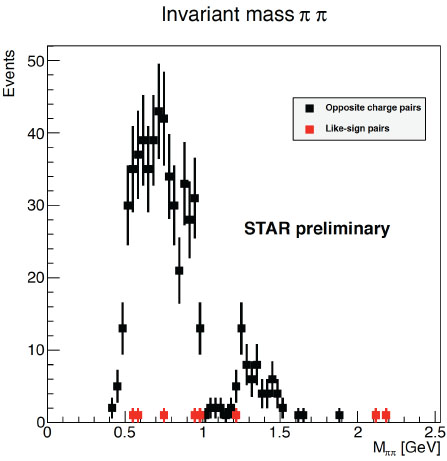 |
Fig.(7). (color online) STAR Preliminary results on invariant mass spectrum of π +π − pairs produced in the central exclusive process p + p→ p +π +π − + p at s = GeV. |
 pairs produced with the above cuts is presented. The like-sign background is very small, which gives a measure of exclusiveness of the process. The spectrum is not corrected for acceptance, but preliminary acceptance study indicates that corrections would not change shape of the spectrum significantly. Presented spectrum is similar to the one published by the AFS Collaboration at ISR [15] as it shows the same characteristic features :
pairs produced with the above cuts is presented. The like-sign background is very small, which gives a measure of exclusiveness of the process. The spectrum is not corrected for acceptance, but preliminary acceptance study indicates that corrections would not change shape of the spectrum significantly. Presented spectrum is similar to the one published by the AFS Collaboration at ISR [15] as it shows the same characteristic features :
• it is dominated by low invariant mass pairs,
 , below 1 GeV;
, below 1 GeV;
• it shows the same characteristic drop around 1 GeV which may be due to
 rescattering or
rescattering or
 (980) interference with the S-wave background [16].
(980) interference with the S-wave background [16].
6. SUMMARY AND FUTURE PROSPECTS
We had a very successful run with the physics program with tagged forward protons at RHIC in 2009, in which over 70 million events (including 33 million events with elastic triggers) were collected. We have published our results on single spin asymmetry (ANand r5) and we are finalizing our results on double spin asymmetries as well as the central exclusive production. In the mean time, we are also preparing for the Phase II of this physics program, in which we change our detector configurations so that we will not need a special optics of RHIC and thus this physics program can be carried out simultaneously with other physics programs of the STAR experiment. This will allow us to take much more data and explore other physics possibilities at RHIC.
CONFLICT OF INTEREST
The author confirms that this article content has no conflicts of interest.
ACKNOWLEDGEMENTS
We thank the RHIC Operations Group and RCF at BNL, the NERSC Center at LBNL, the KISTI Center in Korea and the Open Science Grid consortium for providing resources and support. This work was supported in part by the Offices of NP and HEP within the U.S. DOE Office of Science, the U.S. NSF, CNRS/IN2P3, FAPESP CNPq of Brazil, Ministry of Ed. and Sci. of the Russian Federation, NNSFC, CAS, MoST and MoE of China, the Korean Research Foundation, GA and MSMT of the Czech Republic, FIAS of Germany, DAE, DST, and CSIR of India, National Science Centre of Poland, National Research Foundation (NRF-2012004024), Ministry of Sci., Ed. and Sports of the Rep. of Croatia, and RosAtom of Russia.
REFERENCES
| [1] | (a) Nussinov S. Colored-Quark Version of Some Hadronic Puzzles Phys Rev Lett 1975; 34: 1286-9.; (b) Nussinov S. Perturbative recipe for quark-gluon theories and some of its applications Phys Rev 1976; D14: 246-57. |
| [2] | Akchurin N, Langland J, Onel Y , et al. Analyzing power measurement of pp elastic scattering in the Coulomb-nuclear interference region with the 200-GeV/c polarized-proton beam at Fermilab Phys Rev 1993; D48: 3026-6. |
| [3] | Bai M, Roser T, Ahrens L , et al. Polarized proton collisions at 205 GeV at RHIC Phys Rev Lett 2006; 96: 174801--4. |
| [4] | (a) Okada H, Alekseev IG, Bravar A , et al. Measurement of the analyzing powerAN in pp elastic scattering in the CNI region with a polarized atomic hydrogen gas jet target Phys Lett 2005; B638: 450-.; (b) Alekseev IG, Bravar A, Bunce G , et al. Measurements of single and double spin asymmetry in pp elastic scattering in the CNI region with a polarized atomic hydrogen gas jet target Phys Rev 2009; D79: 094014-1-18. |
| [5] | Bazilevsky A. Measurements of the energy dependence of the analyzing power in pp elastic scattering in the CNI region J Phys Conf Ser 2011; 295: 012096-1-5. |
| [6] | (a) Bültmann S, Chiang IH, Chrien RE , et al. First measurement of AN at √s=200 GeV in polarized proton–proton elastic scattering at RHIC Phys Lett 2006; B632: 167-72.; (b) Bültmann S, Chiang IH, Chrien RE , et al. Double spin asymmetries ANN and ASS at √s=200 GeV in polarized proton–proton elastic scattering at RHIC Phys Lett 2007; B647: 98-103. |
| [7] | Buttimore NH, Gotsman E, Leader E. Spin-dependent phenomena induced by electromagnetic-hadronic interference at high energies Phys Rev 1978; D18: 694-716. |
| [8] | Trueman TL. Hadronic spin dependence and the use of coulomb-nuclear interference as a polarimeter journal nam 1996; [arXiv hep-ph/9610316] |
| [9] | Bültmann S, Chen W, Chiang IH , et al. The PP2PP experiment at RHIC: silicon detectors installed in Roman Pots for forward proton detection close to the beam Nucl Instr Meth 2004; A535: 415-20. |
| [10] | Plyku D. Performance of silicon detectors in polarized proton-proton elastic scattering at RHIC J Phys Conf Ser 2011; 295: 012129-1-5. |
| [11] | Ohlsen GG, Keaton PW Jr. Techniques for measurement of spin-½ and spin-½ polarization analyzing tensors Nucl Instr Meth 1973; 109: 41-59. |
| [12] | http: //www4.rcf.bnl.gov/~cnipol/pubdocs/Run09Offline/ |
| [13] | Adamczyk L, Agakishiev G, Aggarwal MM , et al. [STAR Collaboration] Single spin asymmetry ANin polarized proton-proton elastic scattering at √s=200 GeV Phys Lett 2013; B719: 62-9. |
| [14] | Buttimore NH, Kopeliovich BZ, Leader E, Soffer J, Trueman TL. Spin dependence of high energy proton scattering Phys Rev 1999; D59: 114010--18. |
| [15] | Akesson T, Albrow MG, Almehed S , et al. [Axial Field Spectrometer Collaboration] A search for glue balls and a study of double pomeron exchange at the CERN intersecting storage rings Nucl Phys 1986; B264: 154-84. |
| [16] | Dedonder J-P, Furman A, Kaminski R, Lesniak L, Loiseau B. S-P- and D-wave final state interactions and CP violation in B± → π± π ± π± decays Acta Phys Polon 2011; B42: 2013-43. |


